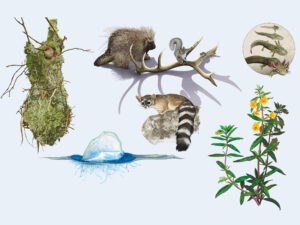Visiting a Bay Area trail would seem incomplete without a glimpse of a fast-moving western fence lizard flitting off a sunny rock or tree trunk. Also called the blue-belly or swift lizard, Sceloporus occidentalis is classified as “common” and is active most of the year, hibernating only in the coldest winter months.
Indeed, the fence lizard does very well in the Bay Area –- and that is very good news. This reptile not only fulfills a large role in local ecosystems as both predator and prey, but it reduces our risk of contracting a dangerous disease.
The western fence lizard eats insects, spiders, and other arthropods, and their impact on populations of these creatures is proportionate to their large numbers. What’s more, they are a favorite meal of kingsnakes, other snakes, hawks, and some mammals. The Alameda whipsnake, a threatened local species, relies especially on the fence lizard for survival. This snake inhabits chaparral habitats in Alameda, Santa Clara, and Contra Costa counties, all prime fence lizard habitat.
These little lizards don’t just provide sustenance for so many predators. They also help protect all of us from Lyme disease. In fact, ticks in regions inhabited by western fence lizards carry Lyme disease 45 percent less frequently than ticks in other regions.
This connection is not a coincidence. The bacteria that causes Lyme disease lives in the guts of ticks and can be passed to a host if the tick stays attached for more than 24 hours. Fence lizards, luckily for Bay Area nature enthusiasts, have another bacteria in their blood that kills the Lyme disease-causing bacteria. So ticks that feed on these reptiles no longer carry the threat of Lyme disease.
Western fence lizards inhabit dry regions from central Washington to Baja California, from coastal habitats to mountainous heights of 6,000 feet, in semi-open woodland and grassland. Only dense or moist forest and open desert habitats don’t receive the Lyme-negating effects of the fence lizard.
How do you look for this beneficial lizard? You’re most likely to see one out of the corner of your eye, since fence lizards have notoriously fast reflexes to avoid their many predators. That’s essential, since the lizards prefer open spots such as low rocks or the proverbial fence post, which makes them easily visible to predators.
Fence lizards are territorial creatures; after hibernation ends in early spring, both males and females establish individual territories they defend with posturing and scent marks. This also marks the beginning of mating season.
Around this time, you may notice the fence lizard doing “push ups” on the ground. That’s a male trying to attract females to his territory. During this interaction, a male will also show his blue belly scales. Males develop this trait during mating season, and that’s why this species is sometimes called the “blue belly.” A female will enter a male’s territory and watch his behavior before deciding whether to mate.
So next time you’re on a hike, take a moment to appreciate that blue belly and his mate–both working hard to feed so many, and make a few more lizards to do the same.

.jpg)



